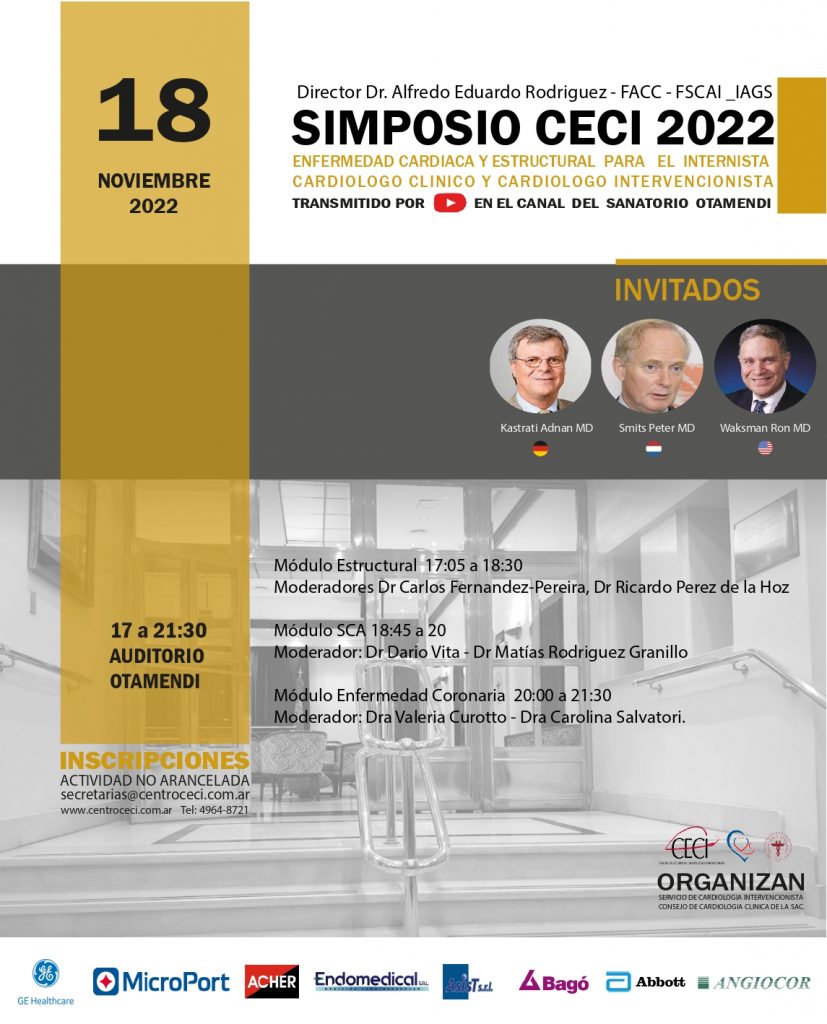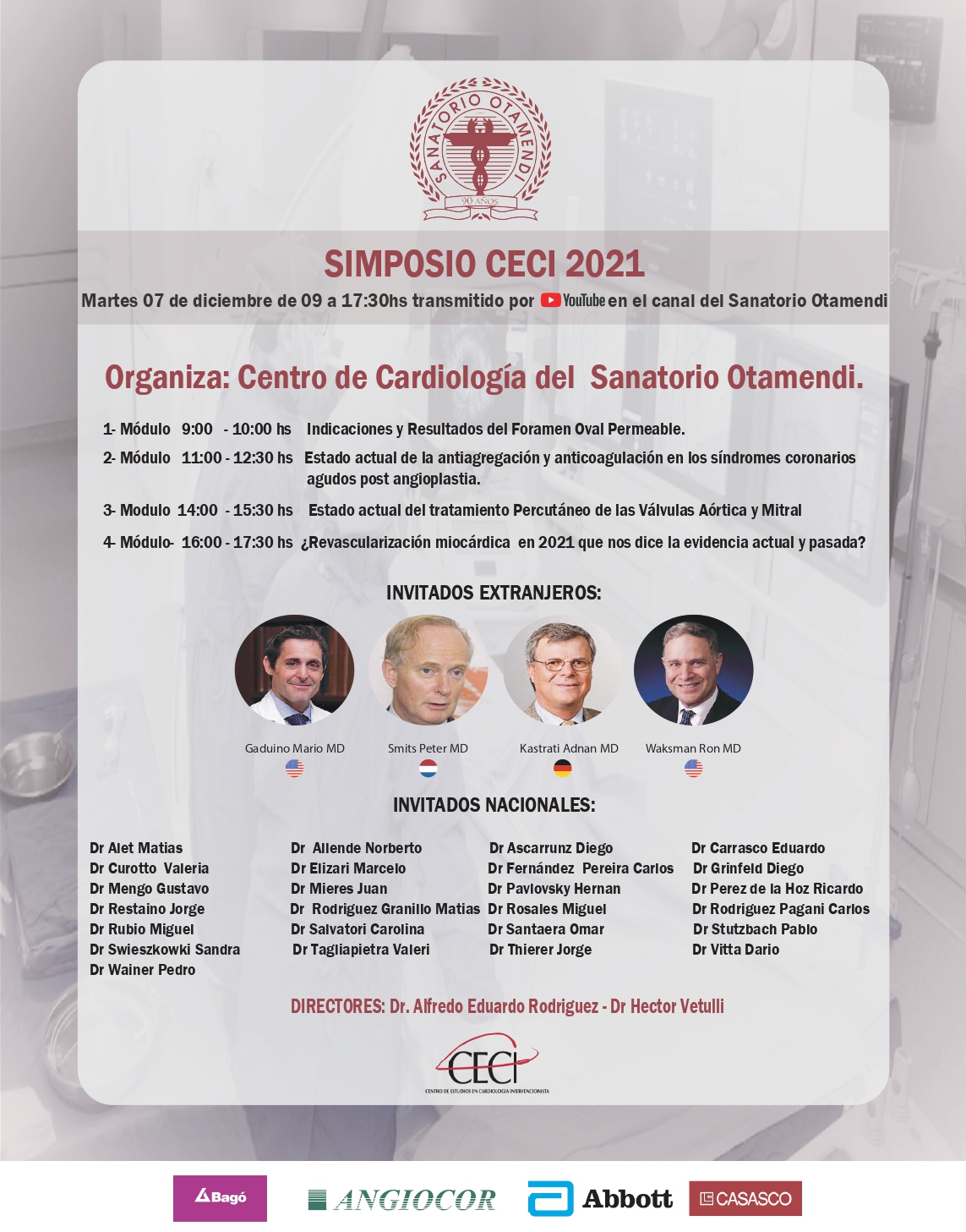Como todos los años, El Centro de estudios en cardiología intervencionista realizo su Simposio Anual, se llevó cabo en el auditorio del Sanatorio Otamendi el día 18 de Noviembre de 17 a 21:30hs.
podrá verlo en este link

Programa CECI 2022
Módulo Estructural 17:05 a 18:30
Moderadores Dr Carlos Fernandez-Pereira, Dr Ricardo Perez de la Hoz.
17:05-17:20 Estado actual de la evidencia de TAVI en estenosis aórtica con riesgo bajo e intermedio.
Dr. Ron Waksman.
17:20-17:30 La relación con la alteración de la conducción AV durante y después del TAVI
Dr. Héctor Vetulli
17:30-17:40 Angioplastia coronaria y TAVI: antes, durante o posterior
Dr.Juan Mieres
17:40-17:55 Casos enlatados de TAVI Vita Flow.
Dr.Carlos Fernandez-Pereira, Hernán Pavlovsky, Dr.Diego Ascarrunz
17:55-18:05 Single,double or triple DAPT post TAVI
Dr. Matías Rodriguez Granillo
18:05-18:20 TAVI en válvula aórtica bicúspide e insuficiencia aórtica: Evidencia clínica.
Dr.Ron Waksman
18:20-18:30 Panel de Discusión. Dr.Eduardo Carrasco ,Dr Hernan Pavlovsky, Dr Camila Gallardo, Dr Federico Vigo, Dra Lucia Fontana.
18:30-18:45 Break
Módulo SCA 18:45 a 20
Moderador: Dr Dario Vita – Dr Matías Rodriguez Granillo
18:45-19:00 DAPT en pacientes con alto riesgo de sangrado
Dr Peter Smits.
19:00-19:15 Evidencia clínica de prasugrel/ticagrelor en pacientes post PCI
Dr Adnan Kastrati.
19:15-19:25 Evidencia clínica de DAPT en pacientes con STEMI y alto riesgo de sangrado
Dr Peter Smits.
19:25-19:35 ¿Clopidogrel debería ser la nueva aspirina en el mantenimiento de la terapia, luego de un SCA?.
Dr Ernesto Duronto.
19:35-19:45 IAM con Múltiples Vasos: La Revascularización «más completa» incluye a la Prevención Secundaria.
Dr Gustavo Samaja.
19:45-20:00 Panel de Discusión :
Dra Bibiana Rubilar- Dr Gaston Procopio- Dra Sandra Swieszkowski, Consejo de
Cardiología Clínica.
Módulo Enfermedad Coronaria 20:00 a 21:30
Moderador: Dra Valeria Curotto – Dra Carolina Salvatori.
20:00-20:10 Rol de las imágenes cardiovasculares, RMN y TMC, en la estratificación de los pacientes coronarios.
Dr. Fernando Dettori
20:10-20:20 Revascularización en pacientes con FEVI deteriorada; estado de la evidencia actual
Dr Jorge Thierer.
20:20-20:30 Porque debemos hacer angioplastia en pacientes crónicos y con deterioro de la función ventricular izquierda después del ISCHEMIA y REVIVED?
Dr Alfredo Rodriguez .
20:30-20:45 Ventajas de la combinación de drogas en los stents liberadores de fármacos para prevención de eventos adversos en población general y en diabéticos
Dr Adnan Kastrati .
20:45-20:55 Podemos usar corta DAPT en pacientes de complejidad media o alta?
Dr Peter Smits
20:55-21:10 Presentación de Casos clínicos.
Dra Giuliana Tresenza
21:10- 21:30 Panel de Discusión.Dr Miguel Rubio,Dr Ruben Piraino, Dr Camila Correa,Dr Carlos Rodriguez Pagani ,Dr Miguel Rosales.
Break y Cena.
Read More

